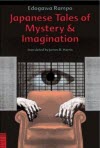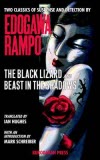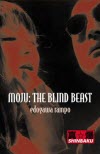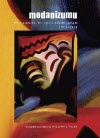The Fiend with Twenty Faces
Jonathan Clements examines the legacy of Ranpo Edogawa, the Japanese master of mystery and imagination, and his infamous master-thief K20.
In a steampunk Japan ruled by a gilded but oppressive aristocracy, the masked anarchist “K20” delivers a resounding curse at the society wedding of police chief Kogorō Akechi (Tōru Nakamura). K20 also frames an innocent man for a terrorist bombing incident, forcing professional gymnast Heikichi Endō (Takeshi Kaneshiro) to repurpose his hard-won circus skills in order to evade the police, catch his tormentor and, in some sense, replace him.
Unspoken but omnipresent in Shimako Satō’s K20 movie, just released on UK DVD, is the sense that her caped vigilante and his underclass allies are this film-world’s inheritors of a different literary tradition: the 20th century potboilers that slipped black-clad, proletarian acrobats into the interstices of history. In setting this reboot in an alternate 1949, before the 1950s explosion of stories in a new genre by Futarō Yamada and Sanpei Shirato, K20 playfully suggests that while its alternate universe might have “fake” history, it swaps it for “real” ninja.
The historical hinge of the K20 film occurs in the prelude to World War Two, when Britain and the United States sign a peace treaty with Imperial Japan. Hence, the war as we know it does not take place, German, not English, endures as the international lingua franca, and Japan’s aristocratic, militaristic society endures until 1949. As the opening credits on K20 breathlessly proclaim, this is a Japan that still clings to a draconian caste system, where marriage outside of one’s class is forbidden, and the lower orders are expected to know their place. Historians might quibble that such proscriptions suggest a much earlier point of divergence from real-world history, as early as 1868, but that’s an argument for another time. So, too, is the question of how the rest of the world looks with Japanese expansionism unchecked — is China now a colony? Is Manchuria still a puppet state?
Dirigibles and microcopters dot the Tokyo skyline, although the city is referred to throughout as Teito (“Imperial Capital”). There are other subtle cues for the home audience to savour – starting with old-fashioned signage that reads right-to-left in the imperial fashion. An opening panorama reveals that the Tokyo Tower, completed in our universe in 1958 and a constant target for giant monsters thereafter, is up and operational ten years early. So, too, is television, with the general population able to watch street-corner sets five years before they were first introduced in the real world. This is a Tokyo that never suffered the 1940s air raids, and hence still largely comprises uncleared samurai-era slums. And because this wouldn’t be sci-fi without a doomsday device, Nikola Tesla has won the Nobel prize, for a remote-transmitting lightning coil that might spell the end of the world.
The Master of the Macabre

K20’s original creator, Ranpo Edogawa (1894-1965) was really Taro Hirai, an author who adopted a punning pseudonym based on his idol Edgar Allan Poe (“Edoga-waran-po“). He was once the head of the Mystery Writers of Japan, and a pioneer of detective fiction in his own country. His “Hell of Mirrors” (1926) dallied with the newfangled genre of scientific romance, with a protagonist who is determined to see his reflection in a “a perfect mirror”. Climbing inside a spherical reflector that promises to magnify his every detail, he is driven mad, and the narrator speculates whether this is some Wildean inner unpleasantness, or a vision of Lovecraftian horror. There were other speculations about optics in “The Man With the Pasted Rag Picture” (1926), in which inverted binoculars are found to offer a magic-realist power over the world. Both these stories are included in the early collection of Edogawa in translation, Japanese Tales of Mystery and Imagination (1956) [Purchase] which was for many years the only source for him in English.

Recent years have seen increased interest in his tales of the macabre, with the English publication of The Edogawa Rampo Reader (sic) [Purchase] and translations of his Blind Beast, Beast in the Shadows [Purchase], and Black Lizard [Purchase]. His legacy has also been reappraised as part of Modanizumu: Modernist Fiction from Japan [Purchase], a pioneering anthology released in 2008. But if Edogawa is known to Anglophone readers, it is usually for his tales of the unexpected, and not for the character who made his fortune in Japan: the tireless detective Kogorō Akechi.
The eccentric Akechi regards himself as a master of disguise, a skill that he puts to good use in numerous grotesque investigations, often with an erotic twist. His first documented case, The Murders on D-hill (1925) revolved around sadomasochistic games gone wrong, reflecting Edogawa’s ongoing obsession with alternate sexualities and erotic titillation. Despite, or perhaps even because of this, Akechi soon achieved prominence as a Japanese analogue to Sherlock Holmes. The first movie based on his adventures was made as early as 1927, and he became a recurring fixture in Shinseinen magazine, where Edogawa was given carte blanche to deliver as many mysteries as he could muster. But despite deliberately far-fetched titles like The Vampire and The Sorcerer (both 1930), Edogawa’s detective stories were resolutely mundane. It was only as he fretted about potential profits that he turned to increasingly fantastic plotlines, gleefully dragging his stories in ever more far-fetched directions an attempt to attract younger readers.
The Boy Detectives Club
Edogawa’s output suffered in the 1930s after a request from the government censor that he not republish “The Caterpillar” (1929), a short story about a crippled war veteran, deemed to be anti-patriotic. Like many other Japanese authors, he dutifully cranked out more martial fare for the war effort, although he did so under other pseudonyms. Meanwhile, the stories of “Ranpo Edogawa” remained largely untouched by propagandistic fervour. As Japan’s militarist culture became ever more hysterically belligerent, Edogawa’s stories soon became almost unique for their lack of wartime awareness.
It was during the 1930s that Edogawa’s Akechi detective stories began to take on notes of the fantastic. Akechi gained a youthful sidekick, Yoshio Kobayashi, as well as his own version of the Baker Street Irregulars: a bunch of Tokyo tykes called the Boy Detectives Club. With Edogawa finding better markets in the children’s sector, these assistants began to edge Akechi out of the limelight, particularly when Edogawa introduced a debonair, masked master-thief to tax their skills.
The Boy Detectives Club series would eventually run to over 40 volumes, although many of them in the post-war years were little more than bowdlerised rewrites of earlier adult Akechi novels. But The Fiend With Twenty Faces (1936) was a true original, written deliberately for the Boy Detectives sub-franchise. The master criminal K20 made his debut here, but would return in many subsequent novels, adding a note of pantomime fantasy to what had previously been serious sleuthing. Edogawa would live to see the cinematic results, in three K20 films released in 1954, and another two as part of a Boy Detectives Club movie franchise in 1956.

There was a further flurry of Edogawa adaptations just after his death, including Kinji Fukasaku’s Black Lizard (1968), and the anime TV series Naughty Detectives (1968). However, the number of film productions based on his work soon began to dwindle. In the seventies there were only three. In the eighties, only one, alongside an execrable kids-TV reboot on roller-skates: Baseball Detectives. It is as if Edogawa’s popularity skipped a generation. But in the last twenty years, there have been over a dozen movies based on his work.
The Return of the Masked Man
In 1984 a series of real-life incidents in Japan brought Edogawa’s creations back into the public eye. An unidentified anarchist group calling itself “The Fiend With Twenty-One Faces” kidnapped the president of a Japanese food company, intending to hold him to ransom. Although the victim soon escaped, the group began a concerted blackmail campaign against food companies such as Glico and Morinaga. Taunting letters to the police claimed that certain brands of candy had been laced with cyanide. The unsolved scandal would lead to the suicide of a police chief, and an unsuccessful nationwide search for a suspect called “The Fox-Eyed Man”.

The media profile was high enough to generate the most obscure Edogawa collectible of all, a Japan-only publication of first Boy Detectives Club novel, translated into English by Gavin Frew in 1988 for the Kodansha English Library line. Meanwhile, authors and manga creators were reminded of the forgotten Edogawa menagerie of characters, and were soon producing new pastiches such as, the masked boy-thief, modelled on Edogawa’s Fiend, who appeared as The Man With Many Faces (1990), a manga series created by the acclaimed all-woman collective CLAMP, and set in the same universe as the same authors’ CLAMP School Detectives. In the CLAMP version, K20 is depicted as a pre-teen schoolboy who leads a double life as a thief in order to placate his demanding twin “mothers”. The story was also a powerful influence on the SF series Ghost in the Shell: Stand Alone Complex, in which a similar mysterious mastermind takes on the government and police for shadowy reasons.
Most prominent among the new re-tellings was The Fiend with Twenty Faces: A Life (1988), by novelist, scenarist and sometime actor Sō Kitamura. Now republished in Japan in an omnibus edition, it began as two novels: The Phantom of the Circus and A Demon in Bronze. In careful imitations of Edogawa’s work as Kitamura believed it would have continued if Edogawa had lived on, Kitamura introduced post-modern sensibilities to characters that have been rendered clichéd by countless copies, and whose attitudes are now seventy years behind the times. He achieved this in the manner of many superhero reboots, by creating a new character to take on the mantle of an aging original. The Fiend with Twenty Faces selects an unwitting victim, circus acrobat Heikichi Endō, whom he moulds into the perfect criminal through a long process of arranged accidents, misfortunes and blackmail. Meanwhile, Kitamura also questioned the nature of such “criminality”, suggesting that a vigilante enemy of a militarist society was not an enemy at all, but more likely to appeal to today’s readers. In this alternate world, could it be that K20 was the good guy?

Critical reaction in Japan to Kitamura’s work was mixed. Some praised his re-imagining of old favourites for a new age; others derided him for a snooty sense of superiority towards the entertainments of yesteryear. In his defence, the wildly different readerships for the linked tales featuring K20, Akechi and the Boy Detectives Club had already made it impossible to please everyone. Amazon Japan’s review pages for the books are a battleground of contending rants between readers who wanted a K20 with grown-up sensibilities, and readers who wanted to revisit the escapism of their childhoods. But in the wake of a decade of Hollywood superhero franchises on the big screen, Kitamura’s re-imagining was snapped up for a live-action movie adaptation.
Screening the Fiend
In adapting a lurid, pulp hero for an undefined modern audience, K20 (2008) stumbles into many of the pitfalls more familiar to Western readers from Hollywood adaptations of comics. There is a strong sense, behind the scenes, that some members of the production crew wanted K20 to be Japan’s answer to V For Vendetta or Batman Begins. We might also regard the protagonist’s edgy, outcast status as a Japanese analogue of Spider-Man.
Production was in the hands of a loose alliance of companies most likely to be in the public eye for their more recent Space Battleship Yamato (2010) although a more relevant work is their earlier Always: Sunset on Third Street (2005). It was this film, also scripted by Shimako Satō, which required VFX work to recreate 1960s Tokyo; we might speculate that an alternate 1940s Tokyo is easier to put together if one can dust off some of the pre-existing computer graphics.
Shimako Satō directs her own script, a hommage, sequel and reboot to Edogawa’s original stories, extending the characters’ timelines into an alternate era where their pre-war attitudes and lifestyles can continue without the trauma of WW2 to alter them. The lithe acrobatics of both the original K20 and his unwitting heir are brought to life on screen by Russian parkour enthusiasts Ruslan Dzhavadov and Oleg Krannyanskiy, adding a sense of vertiginous realism to scenes that would otherwise be overdoses of special effects.
It is, perhaps, too much to hope that a reboot of an old Japanese favourite might jettison whimsy in favour of a gritty update like a Spielberg War of the Worlds, or a Moore Battlestar Galactica. Unfortunately, K20 is also subject to the bad acting that characterises so much modern Japanese TV drama. The movie star leads do their best, but seem baffled by the antics of their co-stars — if only there were another alternate universe, where performers are not encouraged to ham it up to an absurdly counter-productive degree, and which the supporting cast can do more than conspicuously wait to blurt their lines.
K20‘s “production committee” of rights-holders and vested interests runs to 46 names. That might be what it takes to get a big movie off the ground, but it also amounts to 46 cooks fussing over the same broth. Presumably as a result, the filmmakers seem intent on sabotaging their own work with a surfeit of earnest child-actors, littering too many scenes like a living tax on creativity, as if the producers do not believe that anyone over ten could possibly want to watch. But that, at least, is an understandable recreation of the bipolar attitude of the original stories, with Edogawa’s initially visceral, often-bloody murder mysteries slowly transformed across the years into sanitised crime capers for kids.
Shimako Satō’s film is released in the US as K20: The Fiend With Twenty Faces, and in the UK as K20: Legend of the Mask.
Pingback: The Official Schoolgirl Milky Crisis Blog » Blog Archive » Salon Futura #5
Correct me if I’m wrong, but isn’t Edogawa’s work also the basis for the manga and anime “Daughter of Twenty Faces”? That was my introduction to his characters, and I didn’t realize before that that anime’s “Detective Girls” is probably modeled to some extent after the “Boy Detectives Club” you mention.
Yes, Daughter of Twenty Faces is inspired by the Fiend with Twenty Faces, and written with the permission of the Edogawa estate. The “Detectives Girls” are called the “Shojo Tanteidan” in Japanese, a direct parody of the “Shonen Tanteidan” of the original Boy Detectives Club books.
Was The Fiend With Twenty-One Faces really an anarchist group? I thought the general assumption was that they were yakuza.